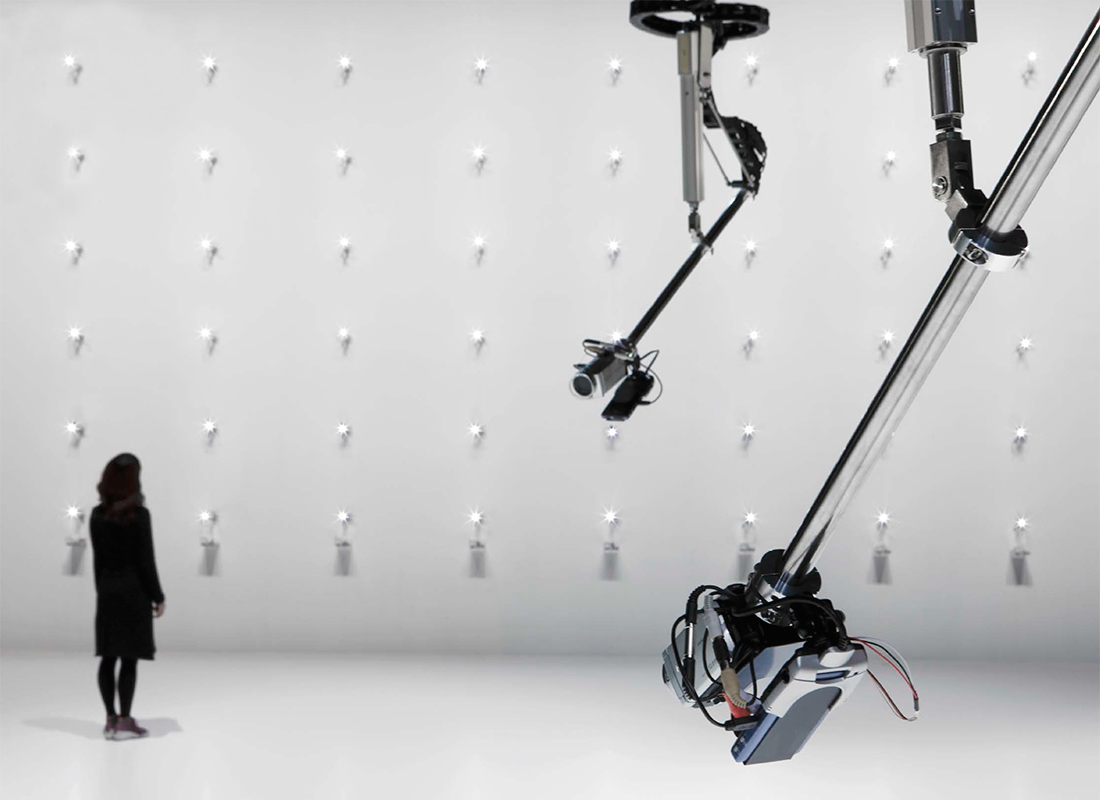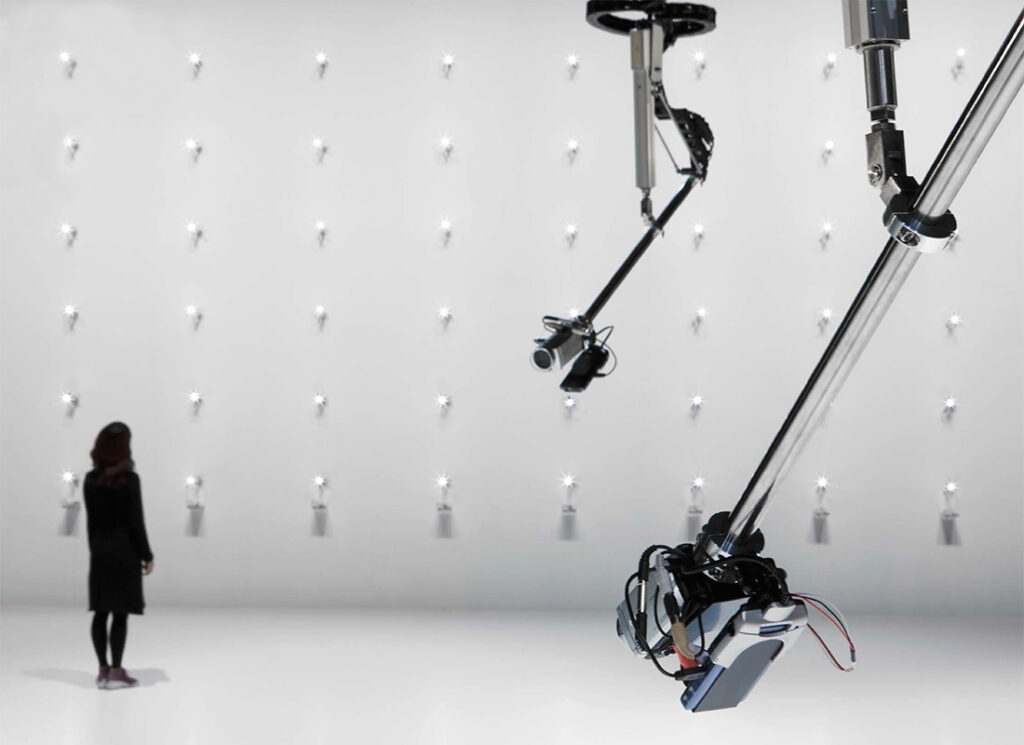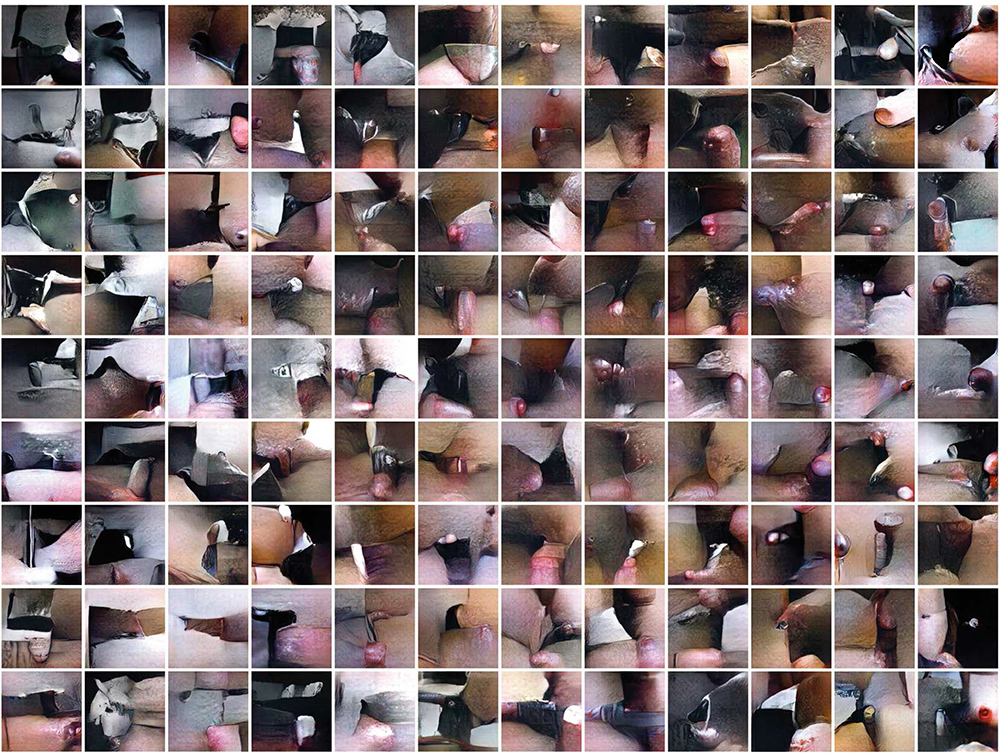Inordinate Images.
On the machine aesthetics of AI-based art
The current rush of attention to technologies of “artificial intelligence” (AI), ranging from governmental funding programmes to advertising campaigns for consumer products and mainstream movies, is indicative of a fundamental concern about the societal repercussions of an, as yet, confusing technoscientific development.1 The art world participates in this discourse through a flurry of exhibitions and public debates, with a noticeable emphasis on the technical and the social, rather than the particular aesthetic and artistic aspects, placing an awkward and, at times, playful or dilettante-like focus on the technical medium. Art criticism perpetuates this tendency when it highlights the societal concerns instead of engaging with the artworks and their aesthetic affordances.
This text argues that works of so-called AI Art deserve, and require, critical scrutiny not only as reflections on a technical paradigm, but as artworks in their own right. Artworks should not be held accountable to “understanding AI,” or offer insights into the functioning or social meaning of its technical supports. Rather, they develop their own scenarios, projecting their own rules and raising their own, hard questions. Take, as an example, Seiko Mikami’s installation Desire of Codes (2010).2 Its main components are a set of robotic arms that investigates the bodies of individual visitors, and an entire wall of small, camera-equipped robotic LED units that follow the visitors like a swarm of clicking lights. The video footage taken by these two components is fed into a kaleidoscopic projection where images of current visitors are mixed with those of visitors from past exhibitions of the installation, stored in the system’s memory, as well as with current images from remote online webcams, sourced directly from the Internet. Without using AI technology in a narrower sense, Mikami’s installation speculates about the possibilities of an encounter with a techno-alien mind that observes as it is being observed, and that tries to understand those who come and visit it. Desire of Codes conveys that questioning in the form of several networked apparatuses attending to the visitors, and a round, mirror-like projection with a myriad of flickering images, disjointed from the visitors’ linear experience of time and space.
In artworks like this one, there are always two separate references to “artificial intelligence:” one to the topic of public discourse, and the other to the technical system employed. The relation between these two is ambivalent and those involved, the artists, technicians, audiences and commentators may construe it differently. AI is not a unified phenomenon, a something to be handled, understood, addressed, but rather a conceptual construct, a discursive tool that both facilitates communication about the technoscientific phenomenon, and over-simplifies it. The current urge to get to grips with AI is understandable, given the radicality with which the related technologies challenge an established understanding of technics that presumes tool-like passivity, rather than active techno-logical agencies, which co-determine what humans can do in the world. But such skewed terminologies, which claim monolithic notions of “intelligence” or “learning” and pitch “human” against “machine,” affirm mythical conceptions of technology and the related schemata of human subjectivity, rather than open them up
to new and alternative narratives.3
The continuing debate about authorship and creativity (“can machines create art?”) is another indication of the persistence of such a mythological, antagonistic conception of the relation between human and technics.4 Any quick review of 20th century art along the line of Dadaism, Surrealism and Pop Art, from Duchamp’s Readymades to Warhol’s silkscreens, will show that such artistic exceptionalism, as a special variant of human exceptionalism, has not been an issue for many modern and post-modern conceptions of art, for almost a century. Other genealogies trace the historical filiations and roots of current AI Art back to early computer art, to the cybernetic art of the 1950 and 1960s, and to 1930s formalism, and art concret. All of these art practices are more concerned with the aesthetics afforded by rational and technical, rule-based systems, and by the encounter with such systems in performative and interactive settings rather than with authorship and original human creativity.5 Viewed from such an art historical perspective, some of the current efforts in AI Art appear somewhat superficial and conceptually unambitious.
In the following, I will address more specifically the aesthetics of some artworks that use machine learning systems, and contextualize them in the framework of what I have elsewhere suggested as aspects of machine aesthetics, which include symbolic references to technology, the formalist appraisal of the beauty of technical objects, kinetics, functional automatism, and machinic autonomy.6 My focus will be on examples of computationally generated images, especially ones using neural networks.7 The style of these images, with its particular, restless transformation of iconic details,8 poised at the edge of recogni-zability, has recently been deployed in works of many artists, including Mario Klingemann, Hito Steyerl, and Trevor Paglen. The imputation delivered with these images is that the technical system, the machine, has created them by itself and for itself, and that what the human viewer gets to see is an insight into the artificial mind’s visual production. Yet, beyond the exposition of an animistic, at times playful fantasy of a dreaming machine, there is seldom any indication of what the technical purpose of these data sets and their processing might be, other than for the operations used in human social contexts, such as the policing function of facial recognition systems, or the generation of artificial facial identities for characters in computer games. The only real purpose of such images—which are not “operational images” in the narrower, technical sense of the term—is to be seen by human observers (and gallery visitors).
A work that does not deny, but rather highlights this human-centred perspective is Jake Elwes’ Machine Learning Porn (2016).9 The work is presented as a silent 12-minute video loop on an LED screen. The film images have a square format, and are shown in an uninterrupted series of short, 20-second segments, a slightly flickering animation of images in which elements resemble details of human body parts, their textures suggesting human skin in lighter and darker hues, ranging from pale pink to purple. All of these visual elements change their shapes continuously, sometimes transforming into abstract surfaces and at other times tending towards the concreteness of male and female sex organs, or patches of pubic hair.
Elwes’ film offers a curious and precise reflection on the voyeurism associated with pornography, dodging recognizability while giving multiple hints at sweaty, blood-supplied skin, at penises, vaginas and mouths. None of these are ever clearly recognizable, concentrating in the square film frame an abstracted essence of pornographic film iconography. In the liner notes on his website Elwes claims that these are “the AI’s pornographic fantasies,” which of course they are not, but rather the output of consecutive runs of a convolutional neural network that “was trained using Yahoo’s explicit content model for identifying pornography.” It is a computational re-interpretation of a data set whose items were collated and tagged by humans in order to serve the automated identification of pornographic content in videos uploaded to online platforms. The film thus shows an abstracted and animated “mirror” image of what pornographic images are expected to look like.
Among the aspects characteristic of a machine aesthetics that articulate the complicated relationship between humans and technics, those of visual formalism, of automatism and of machinic autonomy are prominent in Elwes’ work.10 The formalism here is, unlike many examples from the 1920s and 1930s, not a concern about the quality of particular shapes, their regularity or symmetry, but rather a function of the sliding contours and shape-shifting planes, the gradual emergence and disappearance of colour hues and graphic details. It is a formalism not of stasis and clarity, but one of continuous transformation and semiotic vagueness. These transformations seem to be generated by an automatism that follows an incomprehensible, non-human logic. Given that in the short sequences of the film there tends to be a recurring linear development from more indistinct, planar surfaces (including almost black and almost white surfaces, suggesting abstracted spaces, shadows, dark rooms, white walls) towards images of phallic penetration, this automatism might not be purely technical and semiotically indifferent, but might in fact be grounded in a phallocentric conception of sexuality that is replicated in the information model on which the trained neural networks are based (for instance, through more weight given to particular image types during the training process).
The apparent autonomy of the machine system that has generated the film is not predicated on an independent “pornographic fantasy” (or some sort of “visual pleasure”) of the machine, but rather on its apparent indifference to the affective qualities of the processed images, and its indifference to human comprehension in general. The film displays a deliberate negation of semiotics—in the sense of the construction of decodable, relational meaning—, and an equally deliberate negation of hermeneutics, denying the possibility both of a (human) legibility of the visual output, and of re-constructing its meaning.11
Such an aesthetics of excess that seeks to visually overwhelm and disorient is prevalent in much of the current AI-based art, and in generative art in general—think of the excessive grids and transformations in the works of Frieder Nake, or Manfred Mohr. In the case of Elwes’ Machine Learning Porn, this aesthetics of excess is coupled with the iconographic excessiveness of the pornographic images. To the extent that the denotative quality of the images is submerged in volatile indeterminacy, their iconic quality comes to the fore—not least through the distinctly technical square format of the image frame.
Besides authorship and machine creativity, another ineradicable topic of debate in the wider AI discourse is the role of art in understanding technological and scientific developments. Regularly, “artists” are called upon to educate, elucidate, to imagine, construct, or deconstruct. When asked for help in such an endeavour, Hito Steyerl responded with a reference to the medieval Christian assumption that angels don’t have shadows, retorting with the equally scholastic question: “Does AI have a shadow?” Her own speculative answer was that, perhaps, “AI is the invisible object that already casts a shadow, without anyone knowing what it will be.”12 Any artistic engagement with AI would then imply casting such a shadow, and fore-casting what AI might turn out to be. The art historical contextualization of such practices may perhaps be a valid complement to such predictive soothsaying, since it can serve to read them outside of their ambiguous contemporaneity.13 And further insight can be gleaned from direct comparisons with works of other artists. For instance, the emphasis that Anna Ridler puts on the data sets and on the training data deployed in machine learning systems, by self-producing and even exhibiting these data sets (e.g. for Fall of the House of Usher, 2017, Myriad (Tulips), 2018), helps to underscore, in turn, the dependency of Machine Learning Porn on its particular data sets, and to indicate how the supposedly inherent transformations in the “automatic” image production and agency of machine learning systems can be contested.
In Monica Monin’s discussion of how “artists [create] spaces of contestation and sensibilities of difference across human-machine networks,” she highlights two examples: Peter Dittmer’s Amme (Wet-Nurse) (1994–2001), and the artist group Shinseungback Kimyonghun’s installation Animal Classifier (2016).14 While the former is an elaborate interactive installation that stages an idiosyncratic version of Turing’s imitation game, the latter is an installation of a number of small video monitors, which display strings of multiple still images that result from automated Internet searches. The search terms are taken from an essay by Jorge Luis Borges in which he quotes the fanciful, fictitious classification of animals from a “certain Chinese encyclopedia.”
This classification scheme is not only funny, and well-known, but it also has an important intermediary who should not go unmentioned. Borges’ classification is so well-known because it appears in the preface of Michel Foucault’s book The Order of Things (Les Mots et les choses, 1966) where it is used to illustrate how there are boundaries to what can be thought in a certain period or context, what Foucault calls episteme. His book centres around the epistemology of the modern concept of “Man,” a particular way of thinking of “the human” along the parameters of work, life, and language, that emerges around 1800 and that, according to Foucault writing in 1966, might be replaced by yet another concept in our own extended present of the late twentieth and early twenty-first centuries.
For Animal Classifier, the artists borrowed a sense of humorous absurdity from Borges, supposedly ridiculing the idiocy of the AI-fuelled pattern recognition machine. Yet, their rather redundant usage of the classification, taking its terms at face value, not only achieves less than those few lines of text already had in 1952 and 1966, but they also callously miss the more critical point to be taken from Foucault: namely, that the ways in which animals are classified, and the structures which define what it means to know, to learn, to recognize, will no doubt change. It is not unlikely that, if the modern notion of Man will “be erased like a face drawn in sand at the edge of the sea,”15 the information models generated at Google, Yahoo, and elsewhere, may well determine what is to come in its place.
1. There is an ongoing debate about the appropriateness of the terminology around “artificial intelligence;” I here use the italicized AI to reference the trope of current discourse, not any specific technical system. Accordingly, “AI Art” is a heuristic term that refers to the current discursive context in which certain artworks are grouped and perceived. For critical discussions of this discourse, see for example Matteo Pasquinelli (ed.): Alleys of Your Mind: Augmented Intelligence and Its Traumas (Lüneburg: meson press, 2015); Francis Hunger: “Artificial Des-Intelligence or Why machines will not take over the world. At least not now.” (2017) [On-line]: http://databasecultures.irmielin.org/artificial-des-intelligence/; Clemens Apprich, Wendy Hui Kyong Chun, Florian Cramer, and Hito Steyerl: Pattern Discrimination (Lüneburg: meson press, 2018). Thanks to Francis Hunger and Daniela Silvestrin for their comments on an earlier version of this text.
2. See https://www.ntticc.or.jp/en/feature/2011/Desire_of_Codes/; Andreas Broeckmann: Machine Art in the Twentieth Century (Cambridge MA: MIT Press, 2016), 120–122.
3. For discussions of technical myths, see Donna Haraway, “A Cyborg Manifesto: Science, Technology, and Socialist-Feminism in the Late Twentieth Century” (1985), in Simians, Cyborgs, and Women (London: Free Association Books, 1991), 149–181; Andreas Broeckmann, “The Machine as Artist as Myth,” Arts, 2019, vol. 8, special issue “The Machine as Artist”.
4. See the differentiated discussion of this question in Aaron Hertzmann: “Can Computers Create Art?,” Arts, 2018, vol. 7, no. 2. [On-line]: https://doi.org/ 10.3390/arts7020018.
5. See Andreas Broeckmann, 2019; Fabian Offert, “The Past, Present, and Future of AI Art,” 2019. [On line]: https://thegradient.pub/the-past-present-and-future-of-ai-art/. Some more recent examples discussed in Broeckmann 2016 include works by David Rokeby (Giver of Names, 1990, n-cha(n)t, 2001) and Peter Dittmer (Die Amme [The Wet-Nurse], 1994–2001).
6. For a comprehensive treatment of such aspects of machine aesthetics, see Broeckmann 2016, chapters 2 and 3.
7. As suggested by Offert (2019), much of the current production in this field might soon fade into oblivion, to be replaced by Photoshop filters for general usage of neural network and GAN-style image transformation as a common visual effect. A discussion of, for instance, artworks using AI-based performances or robotic systems, with their aesthetics of physicality, of interactivity, control and feedback, would require a different treatment, as would works that address machine–machine interactions.
8. For the notion of the “iconic,” a term derived from a hermeneutic approach in image theory, see Max Imdahl: “Cézanne – Braque – Picasso. Zum Verhältnis zwischen Bildautonomie und Gegenstandssehen” (1974), in Gottfried Boehm (Hg.), Max Imdahl, Gesammelte Schriften, Band 3: Reflexion – Theorie – Methode (Frankfurt/M.: Suhrkamp, 1996), 300–380.
9. A video excerpt is available at https://www.jakeelwes.com/project-MLPorn.html.
10. See above, footnote 6.
11. Would it make sense to discuss such works in the framework of the concepts of hyperreality and simulacrum as proposed by Jean Baudrillard, and Umberto Eco?
12. Hito Steyerl, “The Language of Broken Glass,” lecture, HKW Berlin, Jan. 2019. [On-line]: https://bit.ly/36owafs.
13. Without seeking to overburden a middleweight work, it might be worth comparing films like Elwes’ with respect to their dynamic treatment of the image surface with iconic strategies of analytical cubism, and their dis-solution of denotative references, of narratives and causalities with those of surrealism; see Imdahl 1974/1996.
14. Monica Monin, “Unconventional Classifiers and Anti-social Machine Intelligences. Artists Creating Spaces of Contestation and Sensibilities of Difference Across Human-Machine Networks,” Digital Culture and Society, vol. 4, no. 1, 219–229.
15.Michel Foucault, The Order of Things: An Archaeology of the Human Sciences (New York, NY: Vintage Books, 1973), 387.
Andreas Broeckmann is an art historian and curator who lives in Berlin. Currently, he is Visiting Professor for Art History and Media Theory at the Academy of Fine Arts, Leipzig (HGB – Hochschule für Grafik und Buchkunst, 2017-2020) and is engaged in the research and documentation project, Les Immateriaux Research. From 2011-2016 he directed the Leuphana Arts Program of Leuphana University Lüneburg. He was the Founding Director of the Dortmunder U – Centre for Art and Creativity (2009-2011) and has curated exhibitions and festivals for major European venues, including transmediale and ISEA2010 RUHR. He holds a PhD in Art History from the University of East Anglia, Norwich/UK, and lectures internationally on the history of modern art, media theory, machine aesthetics and digital culture. He is the author of Machine Art in the Twentieth Century (MIT Press, 2016).








